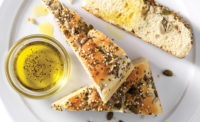New ingredients deliver nutritional and functional benefits for snack and bakery products
Consumers search for more protein and fiber in their diets.




Consumers want to achieve better overall health and wellness, and adding more dietary protein and fiber helps. FDA defines dietary fiber as “certain naturally occurring fibers that are ‘intrinsic and intact’ in plants, and added isolated or synthetic non-digestible soluble and insoluble carbohydrates that FDA has determined have beneficial physiological effects to human health.”
In June 2018, after an extensive scientific review, FDA issued new guidance and identified eight additional non-digestible carbohydrates that meet the definition of dietary fiber. This provides product developers with more R&D tools.
Nutritional, functional fiber
“Fiber continues to be a key formulating tool to improve the nutritional profile of baked goods and snacks,” says Jennifer Stephens, vice president of marketing, Fiberstar, River Falls, WI. Fiberstar recently launched Citri-Fi 150, a natural, non-GMO, allergen-free, plant-based ingredient that contributes fiber and can be labelled as citrus fiber, dried citrus pulp or citrus flour. It qualifies as fiber under the new FDA guidelines.
Nesha Zalesny, technical sales manager, Fiberstar, notes that Citri-Fi 150 can be used in any baked good where control of moisture is essential. “This natural fiber contains both insoluble and soluble fiber, which has high surface area that holds onto high amount of water and oil. Because of its ability to bind water and emulsify oil, it is particularly useful in gluten-free baked goods. It is also advantageous in in-store baked goods like breads, cakes and soft cookies where products stale and harden quickly due to lost moisture. With a small amount of Citri-Fi added to these products, the tender texture of a fresh baked product can be extended for days.”
Fibersol, developed by ADM/Matsutani, is a digestion-resistant maltodextrin that contains 90 percent dietary fiber. It’s water-soluble, has low-viscosity and is process stable. It’s available in many formats, including dry, liquid, agglomerated powder and non-GMO.
Doris Dougherty, Fibersol technical service representative, ADM, Chicago, notes that Fibersol can provide help round-out flavor profiles and reduce harsh notes of some high-potency sweeteners or other ingredients, such as proteins, vitamins and minerals, has no flavor of its own. It has minimal viscosity, so it doesn’t impact texture or mouthfeel. It’s also well-tolerated, helping maintain intestinal regularity with minimal gastric discomfort.
“In many bakery products, such as icings and chocolate compounds, Fibersol can help reduce sugar by as much as 25 percent, and the product will still taste sweet without adding high-intensity sweeteners. In cases such as this, where the original product contains substantial sugar for functionality, not solely sweetness, some of the sugar may be replaced with Fibersol—without detectable loss of sweetness. When greater than 25 percent sugar reduction is desired, a combination of Fibersol and high-intensity sweetener can be used to achieve the desired level of sweetness and sugar reduction. Fibersol helps manage sweetness linger or bitter notes often associated with zero-calorie sweeteners or other ingredients such as proteins,” notes Dougherty.
SunCran Naturelle combines two ingredients: Taiyo’s Sunfiber soluble guar fiber and Fruit d’Or’s Cran Naturelle cranberry juice powder. It offers a solution for product developers looking for prebiotic fiber, combined with cranberry juice benefits, without added sugar. It contains powdered organic cranberry juice combined with organic Sunfiber, notes Derek Timm, technical sales director, Taiyo, Minneapolis. It’s particularly suited to use in fruit-flavored fillings for bars, including reduced-sugar types, he notes. “SunCran Naturelle can also be mixed into a dough or batter to impart cranberry flavor and color without any added sugar, versus using sweetened, dried cranberry.” It’s gluten-free, Non-GMO Project verified, organic, kosher and halal.
Plant-based protein
Plant proteins fit some of today’s biggest trends in product development, says Matthew Jacobs, global product line leader, plant proteins, Cargill, Minneapolis, meshing with non-GMO, organic, sustainable, vegan, gluten-free, soy-free and label-friendly desires.
Cargill has a joint venture agreement with PURIS to expand its portfolio of PURIS pea proteins. “PURIS pea protein is decidedly different. It’s sourced from non-GMO yellow pea seed varieties specially selected to minimize the off-flavors normally attributed to pulses. In addition, it’s processed without the use of hexanes,” says Melissa Machen, senior technical service specialist, plant protein, Cargill. PURIS pea protein is non-GMO, certified organic, gluten-free and soy-free. It can be used across a broad range of snack and bakery applications, including muffins, cookies, breads, pastries and bars.
Max Maxwell, manager, marketing intelligence, Glanbia Nutritionals, Chicago, notes that adding protein to snack and bakery products remains one of the biggest trends driving new product development. “Brands are calling out protein on labels, not as ‘added protein,’ but as ‘high protein’ or ‘source of protein’ as they seek to capture consumer interest and distinguish their products on store shelves.” He notes that whey protein and milk protein continue to dominate in bars.
Glanbia Nutritionals recently introduced Crunchie milk protein crisps and Crunchie pea protein crisps to enhance the amount of protein in snacks, bars and other products. “Crunchie Crisps provide added protein in the form of a particulate that delivers both crunch and visual characteristics to a finished product. Crunchie Milk Crisps are very clean-tasting—a clean-label solution, they provide excellent texture and maintain their integrity in formulation. Crunchie Pea Crisps are designed specifically to deliver superior flavors and performance to snacks and baked goods,” shares Maxwell. Crunchie crisps are ideally suited for cereal bars, energy bars, high protein bars, trail mixes, cookies, clusters, crackers, breads and cereals.
Best of both worlds
Almonds are a nutritional powerhouse, packed with 6 grams of protein and 4 grams of fiber and several essential nutrients in every serving (28 grams). Almonds are known for their heart-healthy benefits, creating satiety to help with weight management, along with energy-boosting qualities.
Almond butter is a versatile option. “Most almond butters are high in protein, contain healthy fats and are high in important nutrients, making them the ideal ingredient to add creaminess and subtle flavor to clean bakery and snack products. We see a huge opportunity here for product developers to blur the lines between the bakery and snack categories by offering satisfying and decadent products that don’t sacrifice on health, such as almond flour and almond butter brownie bites,” shares Molly Spence, director of North America, Almond Board of California, Modesto.
Blue Diamond recently launched its Almond Protein Powder, which offers 40–45 percent protein; is an excellent source of magnesium, phosphorous, manganese and cooper; and is a good source of protein, fiber, potassium, calcium, iron and zinc. It offers a clean taste, smooth texture and abundant health benefits. “Because of its fine texture and mild flavor, Blue Diamond Almond Protein Powder is easy to blend, has a clean taste and requires no masking. The powder produced from almonds is of a fine granulation, resulting in a smooth mouthfeel and clean taste that compliments most every application. Additionally, the powder is non-GMO, gluten free, dairy-free and soy-free, allowing both consumers and manufacturers more versatility in creating a healthy, ‘free from,’ protein-rich snack and bakery foods,” notes Jeff Smith, director of marketing, Blue Diamond Almonds Global Ingredients Division, Sacramento, CA.
Smith recommends Almond Protein Powder for protein and nutrition bars, better-for-you brownies and other baked goods that could benefit from an added punch of protein.
Walnuts are experiencing resurgence in snack and bakery food applications due to their versatility, taste and nutritional benefits, according to the California Walnut Board and Commission, Folsom. The group notes that the number of consumers perceiving walnuts as healthy has increased from 67 percent to 92 percent in the past 10 years.
Jennifer Williams, marketing director, domestic advertising, California Walnut Board and Commission, notes that heart-healthy walnuts are the only nut with a significant amount of alpha-linolenic acid, an omega-3 fatty acid. They also contribute both protein and fiber and are a good source of magnesium and phosphorous.
Williams suggests that in cookies, walnuts provide a premium positioning and nutritional benefits. And in bars, walnuts add flavor, functionality and improved marketability. Bar manufacturers use walnut butter and walnut pieces to improve texture of bars and to provide a sweet, nutty flavor profile. “We’re especially seeing increased walnut usage in bars developed to accommodate specific diets, such as the Paleo diet and plant-based eating,” she says.
Fruitful solutions
Montmorency tart cherries bring a sweet-sour flavor profile, a pop of bright red color, added texture and a halo of potential health benefits to snack and bakery applications like trail mixes, exercise recovery bars, muffins and cookies, notes Mollie Woods, executive director, Cherry Industry Administrative Board. “Montmorency tart cherries are a natural way to help bind dry ingredients, increase moisture and create texture. They also have low water activity for use in low moisture snacks and confections.”
There are over 60 scientific studies demonstrating the potential heath and nutritional benefits of Montmorency tart cherries. Woods notes that studies have shown Montmorency tart cherry juice may help reduce the strength loss and aid recovery after extensive exercise. Research also indicates that Montmorency tart cherry juice, a natural source of melatonin, might help improve the quality and duration of sleep. Montmorency tart cherries are one of the highest sources of phenolic compounds, specifically anthocyanins, which have been shown to fight inflammation and allow tart cherries to help reduce the risk for arthritis and gout, promote cardiovascular health and aid muscle recovery, she notes.
Gut health is an emerging area of interest. “Emerging research suggests Montmorency tart cherries may play a role in improving gut health,” says Woods. “In this first-of-its-kind study, Montmorency tart cherries were found to positively impact gut microbiome—a collection of trillions of bacteria and other microbes that live in the intestinal tract. Researchers believe this is due to high concentration of polyphenols in Montmorency tart cherries, which are broken down by microbes in the gut to stimulate growth of good bacteria.”
Consumers are not looking to give up the foods they love—they are just looking for healthier versions that don’t sacrifice on taste. Adding the range of available ingredients that deliver on both nutritional and functional benefits helps make this possible.
Looking for a reprint of this article?
From high-res PDFs to custom plaques, order your copy today!








